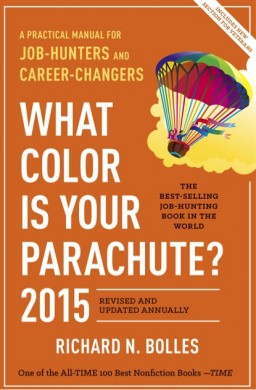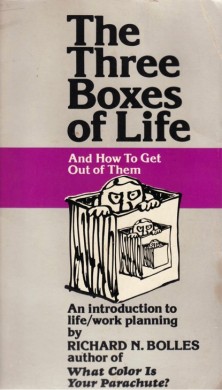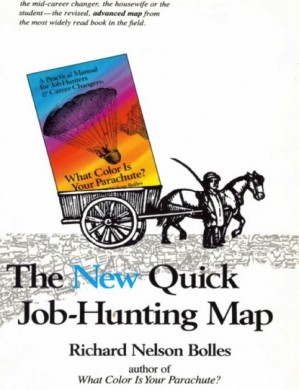Richard Bolles has helped millions of people to find fulfilling work with his ground-breaking book What Colour Is Your Parachute?
First published in 1970, it pioneered the way for many books on job search. Parachute is more than a book for many people: it is a way of life. This article contains four interviews, conducted by Steve Piazzale in 2007, in which Dick explains how people can take charge of shaping their futures.
Philosophy
and background
Parachute has a fascinating history. So how did it start? Dick grew up in New Jersey and served in the US Navy before graduating from Harvard with a degree in Physics.
Deciding to join the ministry, he was ordained in the Episcopal Church, serving in New Jersey and then as Canon Pastor of Grace Cathedral in San Francisco.
By the late 1960s the funding for clergy was being reduced, leaving Dick and many colleagues searching for employment. He managed to get another job supervising campus ministers from various dominations in Western States.
The clergy he met were worried by lack of funding, however, with many fearing losing their jobs. Few looked to the future with hope.
Dick resolved to help. People needed more than encouraging words, however, they needed practical tools that worked. Based on his own experience, he knew some things to offer, but he wanted more concrete information about finding meaningful work. So he travelled the country asking people two questions.
“If traditional job search methods don’t work for you, what is your ‘plan B’? How do you change careers without going back to school?”
During that time he also met John Crystal, who had done considerable research on effective job search methods. Pulling all the information together, Dick began writing what he believed would be a 32 page pamphlet, but it turned into a 128 page booklet.
How did he settle on the title? The worried people he met talked about ‘bailing out’. So Dick jokingly asked: “What colour is your parachute?” The name stuck.
He typed up the manuscript. He then did something he did for every subsequent edition. Pasting up each page, he added drawings and cartoons to bring the book to life.
In those days he took it to the local copy shop. They printed around 100 copies a time and bound it with spiral binding.
Dick sold the book from his office, but mail orders meant he often struggled down to the post office carrying loads of packages. He charged $6.95 for each copy, which covered his costs, plus a small mark-up.
The book was aimed at ministers who faced being laid off. But he soon started getting orders from other occupations and from organisations.
The self-published version sold 2000 copies and attracted the attention of Ten Speed Press, an ‘alternative publisher’ from Berkeley. Parachute has now sold over 10 million copies.
Parachute meets different
needs for different people
Parachute spoke to different needs in different people. Some were simply hungry to find a job. Addressing this need, the book was packed with practical advice on how to conduct a successful job search.
Some people were looking for something more. They loved the book’s emphasis on clarifying their inner drivers – rather than fitting into an outer ‘box’ – and expressing these in their chosen field.
Dick encouraged people to start from within. They revisited their best experiences – such as their previous successful projects – and identified their ‘transferable skills’. For many this brought epiphanies. Everybody is skilled; everybody has something to offer to employers; everybody has something to give to the world.
Parachute combined this inner searching with real-life ‘savvy’. It provided practical tools a person could use to find their preferred ‘field’, research the possibilities and conduct interviews with potential employers.
Testaments to the book’s success arrived at Dick’s door, together with suggestions for future editions.
Dick supplemented the books with keynote speeches and, for 25 years, ran an annual two-week workshop for ‘parachutists’.
He also produced other books, such as The Three Boxes of Life – and how to get out of them. The ‘boxes’ were education, work and retirement, which were seen to correlate to childhood, adulthood and older age. Dick believed it was possible to enjoy learning and play throughout life, for example, rather than only in the designated ‘box’.
Principles
“Define yourself by who you are, rather than who you are not.” This is the clear message of Parachute.
Dick found that people who do meaningful work take some of the following steps.
They clarify: a) their favourite transferable skills; b) their favourite field; c) their offering to an employer.
They clarify and pursue many creative strategies for finding potential employers.
They clarify how they can translate career planning into life planning and give what they can to the world.
One quality is required above all, however, if people want to follow these steps successfully. They must be prepared to do the work. Dick found that this was often the key differentiator. Successful job seekers were prepared to take the time to discover what they wanted to do.
Sometimes this was reflected by readers of Parachute. Those who worked through the exercises reaped the reward. Those who didn’t were less likely to achieve the desired result.
“The secret of a successful job hunt starts with knowing yourself,” is one of the premises of the book.
Parachute is packed with exercises for clarifying your values and vision: who you are, what you believe in and your ideal life. So let’s explore some of these principles, starting with clarifying – in the broadest terms – your ‘skills’.
People can clarify the skills
they can offer to employers
Dick railed against newspaper articles that stated: “American people need to upgrade their skills.” His view was that people already had masses of skills.
The keys were for people: a) To clarify their favourite skills; b) To clarify their favourite field for applying these skills. Let’s explore these two areas.
Clarifying your skills
Everybody has ‘skills’: the question is: “How can you uncover their skills, talents, strengths, knowledge, aptitudes, etc.?” Dick used many exercises to uncover these qualities. Some of these invite you to take the following steps.
Clarifying your success stories.
You are invited to write up to seven short stories, each one about something you have accomplished in your life.
Each story must start with a goal, something you wanted to achieve. It can also include an obstacle you had to overcome.
You then write a step-by-step narrative of how you proceeded, followed by a description of the specific result.
You can do this alone or, if you are on a workshop, you can write the stories, then read these to others in the group.
Clarifying your transferable skills.
Looking at the stories, analyse each one for transferable skills. Dick provides several frameworks for categorising these skills.
One is to list them under the areas of working with ‘People’, ‘Data/Information’ and ‘Things’. Another is to categorise them as ‘Physical’, ‘Mental’ and ‘Interpersonal’.
Dick also talks about them as falling under the categories of ‘Verbs’, ‘Nouns’ and ‘Adjectives’.
In his book What Color Is Your Parachute? For Teens, co-authored with Carol Christen, he cleverly rearranged some of his earliest categories to produce the acronym TIPS. This covered:
T – Working with Things (Physical)
Assembling; repairing; designing; operating; maintaining; constructing; gardening; building, sketching; trouble-shooting; etc.
I – Working with Information (Mental)
Imagining; inventing; researching; testing; measuring; seeing patterns; dissecting; calculating; accounting; computing; filing; sorting; analysing; editing; etc.
P – Working with People (Interpersonal)
Encouraging; caring, nurturing; developing; helping; inspiring; leading; managing; coaching; mentoring; organising; educating; advising; negotiating; entertaining; etc.
“Surely some of the activities overlap the different areas,” somebody may say.
Yes, they do, and mapping these can be part of the fun, because it helps to provide unique combinations. Parachute provides many examples that bring these ideas to life.
Let’s assume you have identified some of your talents. You can now ask yourself:
“What are my favourite skills? If I could only use 2 or 3 skills for the rest of my life, what would they be?”
Settle on these skills – then move on to the next stage.
Clarifying your
Favourite Field
Where would you like to use these skills? What would be your favourite field? Would it be educating, coaching sports, computing, nursing, caring for animals, engineering, cooking, trading or whatever?
Parachute advises asking certain types of questions to establish the field. For example:
“What do you find fascinating? What do you enjoy exploring? What activities give you positive energy? What kinds of problems do you like solving? What do you like to learn about? What kinds of knowledge do you like to share with other people? What kinds of magazines or books do you like to read? If you could write a book – which wasn’t about yourself – what kind of book would you write?”
Imagine you have settled on a field. Return to your favourite transferable skills for a moment. Then ask yourself: “How could I apply my skills in this field?”
Be creative and develop lots of ideas. (This is where a group brainstorm can also help.) The key is to be imaginative. One slight danger is that sometimes people ‘brainstorm’ only within the framework of ‘existing jobs’.
In the old days, for example, if a person loved caring for people, the brainstorm might produce suggestions such as: “Be a nurse, doctor or physiotherapist.”
Nowadays it might produce: “Be a personal trainer, coach or whatever.” Dare to ‘invent’ potential professions.
Imagine you have found ways to apply your favourite skills in your favourite field. Then comes a crucial step.
Dick advocates doing a ‘Practical Field Survey’. Start by identifying people who are performing something like your desired role.
Ask if you can sit at their feet and ask a few questions.(Only a few people may be willing, but they are worth their weight in gold.)
List your questions ahead of time. Make sure these will uncover the real truth, but in a positive way. So you may ask the person:
“What got you interested in this kind of job? How did you set-out to develop your skills? Who did you talk with and learn from? Did you have any models? How did you take steps to actually start doing the work?
“What is the job really like? What does your day look like? What are the parts you love? What are the parts that are more boring? How do you manage to build on your strengths and compensate for any weaknesses?
“What are the 3 questions you would advise somebody to ask themselves if they were considering coming into this profession?”
Parachute underlines the importance of gathering such information. You may, for example, have heard a person say something like: “My dream is to run a restaurant.”
Sounds great, but have they done the research? Do they know what it is really like? Dick advises doing whatever you can to discover the truth, warts and all.
Let’s assume that: a) You know your favourite skills; b) You know your favourite field: c) You know how to apply your skills in this field.
Having clarified your ‘perfect role’, the next step is to find such a position. (Let’s assume that you are aiming to work within an organisation, rather than set-up your own business.) You are now ready to follow another key principle outlined in Parachute.
People can pursue the most
successful methods for job search
Parachute outlined extremely practical methods for increasing the chances of gaining a job. In the process it tackled many myths.
During the early 1970s many people followed ‘conventional’ method for finding work. The book described: ‘The five best ways to find a job,’ and: ‘The five worst ways to find a job’.
Each route was accompanied by the percentage chances of success. Dick outlined the most successful method, which had an 85%+ chance of gaining meaningful work. This included:
– Being prepared to do lots of homework on yourself;
– Knowing your favourite skills and favourite field;
– Knowing how to apply your skills in that field;
– Talking to people and doing research in that field;
– Choosing places you want to work, rather than just those places advertising jobs;
– Researching those organisations thoroughly before approaching them;
– Identifying the actual person – or people – who have the power to hire you for the job you want to do;
– Showing them how you can help the organisation to tackle its challenges or achieve its picture of success;
– Developing skills for conducting interviews in a way that demonstrates your qualities as both a person and a professional.
Do these methods still apply? Do they work, even in the days of the Internet? Dick maintains they do, perhaps even more so.
The eternal principles are to: define what your offer; build and maintain your network; and show how you can help employers to achieve success.
Sounds common sense, but it also calls for sweat. It calls for ‘making getting a job a full-time job’. This means working at least 40 hours a week following these principles – rather than sending out some letters and hoping things will happen.
People can follow
their mission in life
Dick believes the principles that people follow for career planning can lead to life planning. A person may express these in different ways at different stages of their life. For example:
* During the first third, they may ask:
“How can I earn enough money to support my life-style?”
* During the middle third they may ask:
“How can I support my loved one, yet also do more fulfilling work?”
* During the latter third they may ask:
“How can I find and follow my mission in life? How can I give my best to other people? How can I help to build a better world?”
These stages obviously differ from person to person. Frequently we ask the ‘mission’ questions during young adulthood.
Some people pursue these themes at that stage and translate them into meaningful work. Other people put the questions on the ‘back burner’. They may then revisit the mission themes after hitting a crisis, for example, that gets them to take stock of their lives.
Dick has strong Christian beliefs. Yet he also recognises that others may have a secular mission or vocation.
Parachute includes many exercises that encourage readers to explore the key themes – the red threads – in their lives. The beauty of these exercises are that they enable you to follow your mission whilst also, if appropriate, paying the mortgage.
Practice
So what have been the effects of Dick’s work? Writing for the magazine Fast Company, Daniel Pink started his article about Dick by explaining the effect of Parachute:
“In 1991, the Library of Congress surveyed more than 2,000 readers and crafted a list that it grandly called ‘25 books that have shaped readers’ lives.’
“The list included many of the usual suspects: The Bible, of course, Don Quixote, The Catcher in the Rye.
“But there at the bottom, lodged alphabetically between War and Peace and The Wizard of Oz, was a business book – the only such book on the list, and the only volume, fiction or nonfiction, whose title poses a question: What Color Is Your Parachute?”
Dick’s approach to job search has given birth to hundreds of books on finding meaningful work.
Many of the concepts have also become part of career development programmes for organisations and government agencies.
(Whether these are used in the spirit Dick intended is perhaps a more debatable issue.)
Millions of people have benefited from reading Parachute, however, and put the ideas into practice.
Dick provided the paradigm and showed what was possible. “I’m a switchboard. I stay accessible and people tell me what works well and what doesn’t.”
Some switchboard: he has helped many people to follow their life mission.
Dick has created a remarkable legacy. He has helped many people to live more meaningful lives.










Leave a Reply